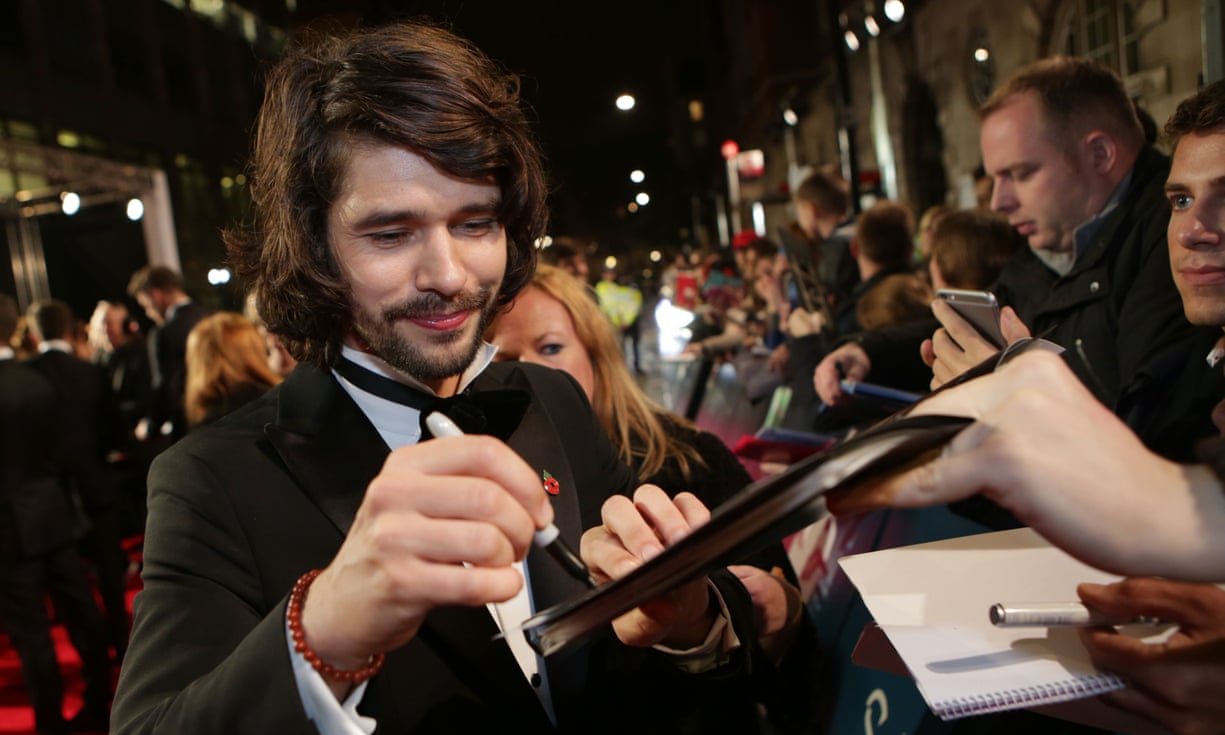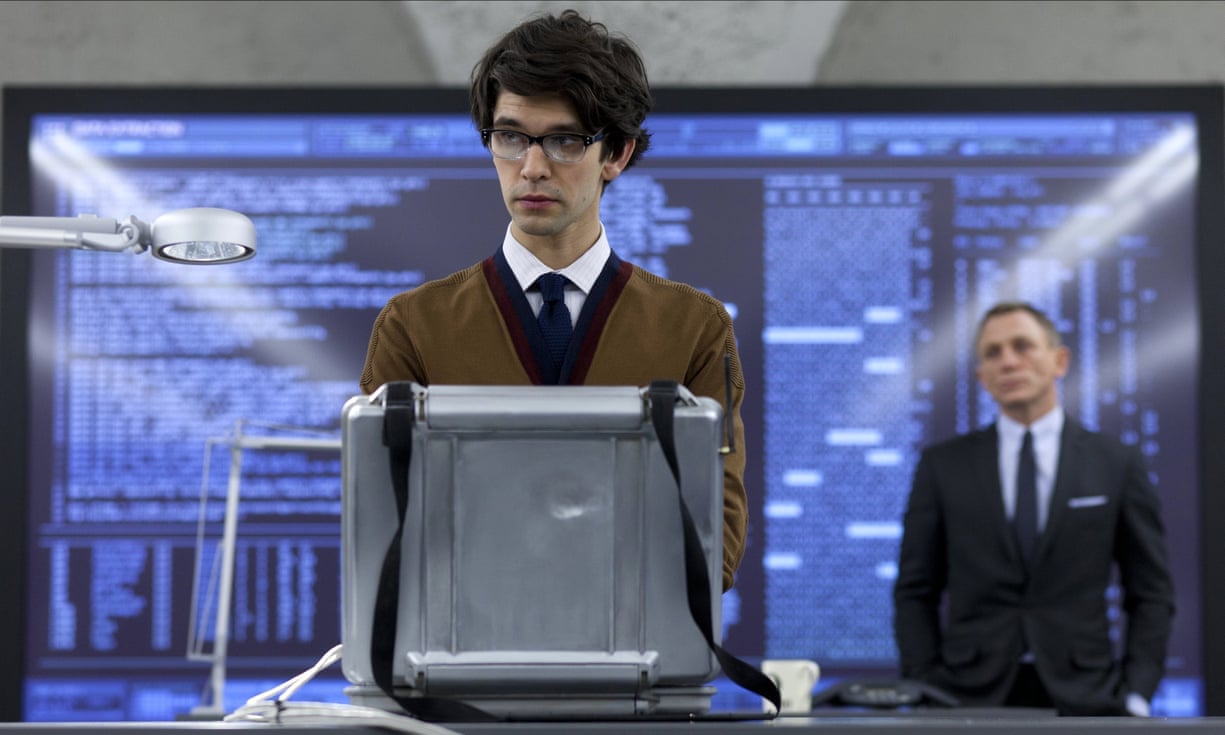http://www.theguardian.com/culture/2016/mar/13/ben-whishaw-soulful-brit-who-charmed-new-york-the-crucibleBen WhishawThe ObserverBen Whishaw
leads the soulful shift in what it means to be a leading manBroadway audiences are flocking to a new take
on Arthur Miller’s Crucible hero. Does emotional
range now play a bigger role than classic looks?By Edward Helmore in New York
Saturday 12 March 2016 19.05 EST Ben Whishaw signs autographs at the London premiere of Spectre last October. Photograph: Jonny Birch/REX/Shutterstock
Ben Whishaw signs autographs at the London premiere of Spectre last October. Photograph: Jonny Birch/REX/ShutterstockThe buzz outside the
Walter Kerr theatre was palpable. The reason: a new production of
Arthur Miller’s beloved witch trial drama
The Crucible, directed by
Ivo van Hove – fresh from
David Bowie’s
Lazarus – scored by
Philip Glass, and starring
Saoirse Ronan alongside exciting new British import
Ben Whishaw, as doomed farmer
John Proctor.
Not just another night on Broadway but casting that seems to point in a new direction for a role that’s traditionally played by actors with a heavier, more overtly masculine presence. Whishaw, theatregoers said, represents an exciting change in the description of the leading man.
“He’s exciting – part of an emerging ideal for male leads – androgynous, malleable, sensitive,” offered New York audience member
Chris Hoppus. “He’s nothing like the classic male leads, the
Cary Grants or
George Clooneys. It’s a new thing – people want to see emotional range from leading men.”
Whishaw’s arrival in Manhattan has been loudly proclaimed. A lengthy story in the
New York Times announced him as “one of the most celebrated stage actors of his generation”, adding that “his calling card is a soulful fragility, all faun-like bearing and saucer eyes, with a teenager’s unruly mop mane”.
Well-known to British audiences, Whishaw remains relatively unknown in the US. His civil partner is
Mark Bradshaw, an Australian composer, but it is his acting style more than his sexual identity that marks a change. Along with actors such as
Eddie Redmayne and
Ansel Elgort, Whishaw represents a new dimension of leading men who are finding their place just as Hollywood is attempting to challenge the cliches of typecasting.
The recent controversy over the lack of racial diversity in Hollywood films is only one aspect of the changes taking place across film and theatre. One of those is to do with leading men, say casting directors, and what audiences want to see in them.
For Whishaw to play Proctor, said theatregoer
Terrence Anderson, was a casting choice that runs against type. “The part is usually portrayed by a sturdy, solid man.
Liam Neeson was in the previous adaptation,
Daniel Day Lewis in the film. Ben Whishaw could not be more opposite.”
The emergence of actors like Whishaw, who played the lovelorn
John Keats in
Jane Campion’s
Bright Star,
Sebastian Flyte in the 2008 adaptation of
Brideshead Revisited, and appeared in the BBC series
London Spy, poses a dilemma for film-makers.
 Ben Whishaw as Q in Skyfall. Photograph: Sony Pictures/Allstar
Ben Whishaw as Q in Skyfall. Photograph: Sony Pictures/AllstarWith recent discussion about who might play the post-
Daniel Craig James Bond focusing on the required components of masculinity, sexual orientation and ethnicity, Whishaw has already blown through the long-running franchise, playing
Q in the last two movies,
Skyfall and
Spectre. “He’s utterly charming and vulnerable, yet he’s the smart one who will figure everything out,” says Hoppus. “James Bond definitely stepped up his global profile.”
While the sensitive leading man is not unique in Hollywood –
Gregory Peck, Henry Fonda and
James Stewart come to mind – casting directors say they are being asked to present more choices to directors and producers.
“Times have changed. We’re no longer just looking for the typical handsome leading man,” says New York agent
Liz Lewis. “People want more character and life behind the eyes, and not just a pretty face without a lot of depth.” But that’s just one aspect of the changes. At the other extreme, says Lewis, are ultra-males like
Chris Hemsworth and
Chris Pratt who find their parts in comic book action films. “The male hunk is still the male hunk, but instead of looking for pretty faces we’re looking for range and depth. People are open to much more diversity and they want something new and different.”
The diversity crisis at the Academy Awards last month has acted as a wake-up call for the industry, Lewis says. Over the past month, a slew of diverse stories and what are now called “colour-blind castings” have increased, among them the young
Barack Obama movie,
Barry, and Disney’s immigrant story
Dr Q. Kathryn Bigelow is set to make a film set during the 1967 Detroit riots; Fox Studios is making
Hidden Figures, a film about the female African American mathematicians who helped Nasa launch its first space missions.
In other instances, non-white actors have been cast in roles written for white actors, among them
Idris Elba, who is set to star in the romantic drama
The Mountain Between Us that once looked to be going to
Charlie Hunnam. Puerto Rican actor
Lin-Manuel Miranda will play the
Dick Van Dyke role in a sequel to
Mary Poppins, while black actor
Michael B Jordan will take the lead role in MGM’s remake of
The Thomas Crown Affair, previously played by
Steve McQueen and
Pierce Brosnan.
Casting directors say they are expecting a huge shift in the range of actors they are being asked to present to directors and producers. “The Oscars controversy was a wake-up call to examine our role in expanding opportunities,”
Star Wars director
JJ Abrams told the
Hollywood Reporter last week. “It’s good for audiences, and it’s good for the bottom line.”
The shift is not merely to do with colour or questions of masculinity. Gender, too, is up for grabs. Casting directors point to the astonishing casting of comedian
Louie Anderson as a midwestern housewife in the television comedy
Baskets.“Three years ago the
Casting Society of America had a meeting about what we could do to make casting more diverse,” recalls New York casting director
Allison Twardziak. “We talked about casting people with physical disabilities, and different body types, age. So we’ve been looking at what can we do and trying to come up with other ideas.”
At the same time, it has been widely noted, the push for diversity could be leaving American actors out in the cold. In a widely circulated article in
The Atlantic last year,
The Decline of the American Actor,
Terrence Rafferty asked if it was time for US actors to take a hard look in the mirror because they are routinely losing out to British and other non-American actors.
Michael Douglas, Rafferty noted, had described “a little crisis going on among our young actors”.
“There’s no such thing as an American male lead actor,” said one theatregoer. “Even the ones who you think are American are probably Canadian.”
In its profile of Whishaw, the
New York Times noted how, as an actor, he rejects the idea of type and has a “slippery way of inhabiting heroes and antiheroes alike, of seducing women and men on screen and on stage with equal ease”.
At The Crucible performance, audience members said they were struck by how questions of sexuality are now almost unremarkable.
“Things have changed so much in the last five or 10 years,” said Hoppus’s partner,
Craig Stekeur. “It’s gone from being freakish and career-killing to something people don’t even bat an eye about. Now, it’s oh, OK. That’s great …”
Of course, acting on Broadway in New York is different from Hollywood. Given the recent controversy over the possible casting of a black Bond, a gay Bond is hardly likely either. But what about a bisexual or sensitive Bond? Twelve years ago,
Rupert Everett was asked if he’d play Bond. “It won’t happen because Bond fans would burn down MGM if the studios got a gay actor to play James Bond. There was never going to be an alternative gay Bond either.” Possibly it’s still too soon, but the casting of Whishaw as the all-American John Proctor is a significant advance. “He’s beautiful and he seems very sensitive,” said Anderson. “There’s a new male lead and it’s a reflection of the times.”